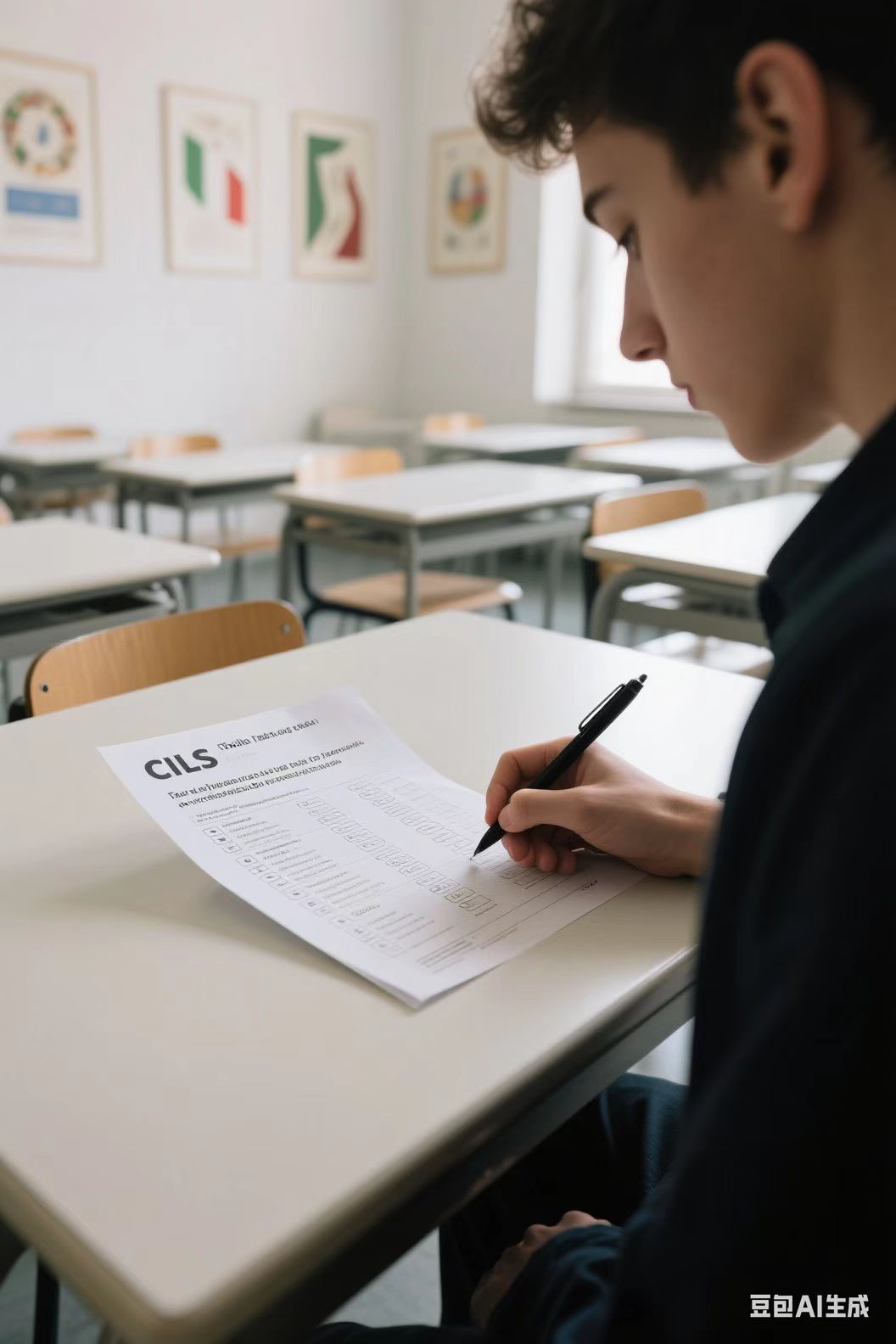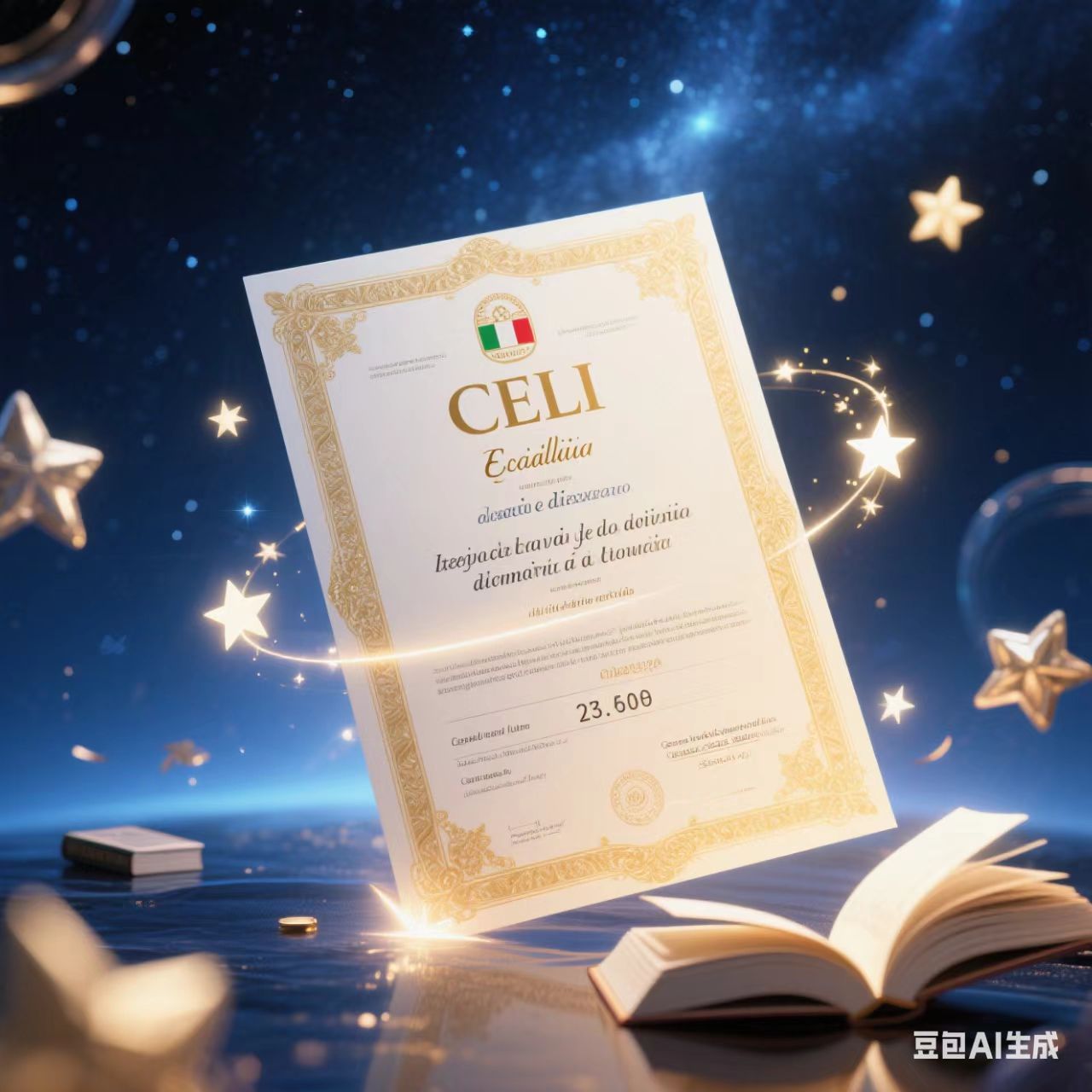

意大利语CELI考试(Certificato di Conoscenza della Lingua Italiana)由佩鲁贾外国人大学(Università per Stranieri di Perugia)组织,是全球最权威的意大利语水平测试之一。该考试完全遵循欧洲语言共同参考框架(CEFR),从基础到精通划分为A1至C2六个等级。以下是各等级的详细划分及核心信息:
一、等级划分与能力要求(对应CEFR标准)
1. CELI入门级(A1)
- 语言能力:
- 理解并使用日常基础表达(如问候、购物、自我介绍),能进行简单交流。
- 掌握约800个基础词汇,能用短句描述个人信息和日常活动。
- 考试内容:
- 听力:日常场景短对话(如超市、学校)。
- 阅读:简单通知、明信片或短文本。
- 写作:填写表格或撰写2-3句的简短留言。
- 口语:自我介绍、回答简单问题(如“你住在哪里?”)。
- 适用场景:初学者入门,满足基础旅游或短期交流需求。
2. CELI 1级(A2)
- 语言能力:
- 理解日常对话和简单文本(如新闻标题、使用说明),能连贯描述日常生活经历。
- 掌握约1500个词汇,能用句子讨论事件、计划或喜好。
- 考试内容:
- 听力:关于家庭、工作的对话或广播短节目。
- 阅读:短文(如博客、公告),理解具体信息。
- 写作:撰写50-80词的短文(如描述一天的活动)。
- 口语:描述图片或谈论习惯、爱好。
- 适用场景:满足基础生活需求(如意大利移民语言证明)。
3. CELI 2级(B1)
- 语言能力:
- 在工作、学校或社交场景中交流,理解中等难度文本(如新闻、故事),能表达观点和计划。
- 掌握约2500个词汇,能用复合句叙述事件或解释原因。
- 考试内容:
- 听力:访谈或广播节目,理解主要观点和细节。
- 阅读:文化、旅游主题文章,分析主旨和态度。
- 写作:80-100词的应用文(如邮件、推荐信)。
- 口语:角色扮演(如预订酒店)和简短演讲。
- 适用场景:意大利大学预科语言要求、初级工作签证语言证明。
4. CELI 3级(B2)
- 语言能力:
- 应对学术或专业场景(如课堂讨论、商务沟通),清晰表达复杂观点,理解隐含意义。
- 掌握约4000个词汇,能逻辑连贯地撰写议论文或报告。
- 考试内容:
- 听力:学术讲座或电视访谈,抓取细节和论点。
- 阅读:文学选段或评论文章,分析结构和作者意图。
- 写作:150-200词的议论文(如社会问题分析)。
- 口语:就社会话题辩论、解释图表数据或讲述个人经历。
- 适用场景:意大利大学本科入学语言要求(部分专业)、中级职场交流。
5. CELI 4级(C1)
- 语言能力:
- 精通复杂语言运用,理解专业文献、文学作品,自然表达抽象概念和文化见解。
- 掌握约6000+词汇,准确使用高级语法和修辞。
- 考试内容:
- 听力:专业研讨会或高难度访谈,理解深层含义。
- 阅读:学术论文、法律文件或文学评论,分析论证逻辑。
- 写作:250-300词的学术论文或文学分析,结构严谨。
- 口语:就哲学、艺术等抽象话题发表演讲,回应批判性问题。
- 适用场景:意大利大学硕士/博士入学、学术研究或管理岗位。
6. CELI 5级(C2)
- 语言能力:
- 接近母语水平,应对所有复杂场景(如即兴演讲、文化批判),精准把握语言细微差别。
- 掌握专业领域词汇,能即兴创作或进行深度学术讨论。
- 考试内容:
- 听力:高速访谈或学术辩论,捕捉未明确表达的观点。
- 阅读:抽象文学作品(如诗歌、哲学著作),分析象征意义。
- 写作:文学评论、政策建议等专业文本,展现批判性思维。
- 口语:即兴辩论(如社会伦理问题)、文化现象解读,语言流畅自然。
- 适用场景:专业领域权威认证(如翻译、语言学研究)、外交或高层学术交流。
二、考试结构与评分标准
1. 模块设置(各等级一致)
- 笔试:
- 听力:20-35分钟,含选择题、填空题。
- 阅读:30-60分钟,考查细节理解与推理判断。
- 语法:60分钟(B2-C2级别),侧重句子结构和动词变位。
- 写作:45-120分钟,根据等级要求完成短文或专业写作。
- 口试:
- 口语:10-25分钟,含模拟对话、主题演讲和互动问答。
2. 评分规则
- 总分计算:100分制(部分级别笔试和口试分开计分,如B2笔试140分+口试60分,总分200分)。
- 及格线:
- A1-A2:总分≥60%(如36/60分)。
- B1-C2:总分≥60%(如60/100分),且各模块≥50%分数。
- 示例:B2级别需总分≥117/200分(笔试≥84/140分+口试≥33/60分)。
- 补考政策:未通过模块可在1年内补考,已通过模块成绩保留。
3. 考试时长
- A1-A2:约2.5小时(含口试)。
- B1-B2:约3.5小时。
- C1-C2:4-5小时(写作和口试难度显著增加)。
三、CELI考试的特点与认可度
1. 核心优势
- 官方权威性:佩鲁贾外国人大学主办,意大利教育部认证。
- 全球通用性:证书终身有效,被意大利高校、欧盟机构及驻华使领馆广泛认可。
- 学术导向性:侧重结构化写作和批判性分析,尤其适合B2-C2级别的学术场景。
2. 适用场景
- 留学:意大利所有公立大学均接受CELI证书(B2及以上通常为本科入学最低要求,C1为部分硕士专业要求)。
- 移民与工作:意大利家庭团聚签证、长期居留或欧盟蓝卡的语言证明(通常需A2-B1)。
- 职业发展:外贸、文化交流、旅游等行业的语言能力背书,尤其适合对意大利语要求较高的岗位。
3. 与其他考试的对比
- CILS:锡耶纳外国人大学主办,兼顾学术与日常应用,口语更强调互动性。
- PLIDA:但丁协会颁发,注重商务场景,C2级别含翻译模块。
- CELI:以学术严谨性见长,写作任务强调逻辑结构和文化理解。
四、备考建议
1. 官方资源
- 教材:
- Nuovo CELI系列教材(分等级配套练习)。
- Grammatica Italiana(意大利语语法权威书,适合B2-C2进阶)。
- 模拟题:佩鲁贾外国人大学官网提供历年真题及评分标准(链接)。
2. 重点突破
- A1-A2:强化日常词汇和基础语法(如动词变位),多听意大利语儿歌或短对话。
- B1-B2:通过意大利语新闻(如《共和报》)提升阅读速度,练习议论文写作框架。
- C1-C2:精读文学作品(如薄伽丘《十日谈》),参与学术讨论或辩论俱乐部提升思辨能力。
3. 考试报名
- 时间:每年固定考试周期(如3月、6月、9月、12月),需提前1-2个月通过授权考点注册。
- 费用:约750-1300元/次(C2级别费用最高),补考费约840元/模块。

意大利语I.T考试(Certificazione di Italiano)由罗马第三大学(Università degli Studi Roma Tre)主办,是意大利官方认可的语言水平测试之一,主要面向非母语学习者。其等级划分与欧洲语言共同参考框架(CEFR)部分对标,但覆盖范围和考试结构具有自身特点。以下是基于最新信息的详细解析:
一、等级划分与能力要求
I.T考试分为 A2、B1、B2、C1、C2 五个等级,其中C1和C2为高级别,侧重复杂场景的语言应用能力。具体划分如下:
1.A2(基础级)
- 能力:理解日常简单对话和文本(如购物、旅行),能用短句表达基本需求。
- 考试内容:听力(短对话)、阅读(广告、通知)、写作(简短留言)、口语(日常交流)。
- 用途:满足基础生活需求,部分移民申请可能要求A2证书。
2. B1(进阶级)
- 能力:在工作或社交中进行连贯交流,理解中等难度的文本(如新闻、指南)。
- 考试内容:听力(访谈、广播)、阅读(文章细节分析)、写作(意见邮件)、口语(讨论社会话题)。
- 用途:商务沟通、留学语言门槛(部分院校要求B1)。
3.B2(高阶级)
- 能力:应对学术或专业场景,能清晰表达观点并进行逻辑论证。
- 考试内容:听力(学术讲座)、阅读(报告、文学片段)、写作(议论文)、口语(辩论与问题解决)。
- 用途:大学入学(部分专业要求B2)、中高级职业需求。
4.C1(流利级)
- 能力:熟练运用语言,理解隐含意义和文化 nuances,处理高难度文本(如法律文件、文学作品)。
- 考试内容:听力(专业研讨会)、阅读(深度分析文章)、写作(学术论文)、口语(批判性讨论社会议题)。
- 用途:学术研究、高级管理职位、翻译工作。
5.C2(精通级)
- 能力:接近母语水平,能自然应对所有复杂场景,包括即兴演讲和文化批判。
- 考试内容:听力(高速访谈)、阅读(抽象文学作品)、写作(文学分析)、口语(即兴辩论与文化解读)。
- 用途:学术出版、外交、专业领域专家认证。
- 特殊要求:C2级别额外考察语法深度应用。
二、考试结构与评分标准
1.模块设置
- 所有等级均包含 听力、阅读、写作、口语 四个模块,无单独语法测试(C2除外)。
- 题型以选择题为主,写作部分要求75–150词(A2–B2)或学术论文(C1–C2)。
- 口语考试包括对话、独白和辩论,时长随等级增加(A2约10分钟,C2约15分钟)。
2.评分规则
- 总分100分,各模块单独计分(听力、阅读、写作各25分,口语25分)。
- 及格标准:总分≥60分,且各模块≥15分。
- 未通过模块可在18个月内补考,保留有效成绩。
3. 考试时长
- A2–B2:笔试约3小时,口语10–15分钟。
- C1–C2:笔试4小时以上,口语15分钟以上。
三、考试特点与认可度
1.灵活报考
- 允许跨级报考(如直接考B2),但需评估自身水平。
- 考试时间灵活,每年多次全球开考(如2025年4月、8月、10月)。
2.认可度
- 证书终身有效,被意大利政府、大学及国际机构认可。
- 尤其受劳务市场青睐,适合移民和职业发展。
- 部分意大利大学接受I.T证书作为入学语言证明(如B2对应直接入读专业课程)。
3.与其他考试的对比
- PLIDA/CILS/CELI:覆盖A1–C2全级别,侧重学术或移民用途。
- I.T考试:聚焦中高级别(B1–C2),强调实际应用能力,适合职场和学术场景。
四、备考建议
1.教材推荐
- 官方教材:《Nuovo Sguardo Italiano》系列。
- 模拟题:参考罗马第三大学发布的历年真题,重点练习听力速记和写作逻辑。
2.重点提升
- C1–C2级别:加强文学赏析和批判性表达能力,积累专业领域词汇。
- 口语:通过角色扮演和辩论练习,提升即兴反应能力。
3.官方资源
- 考试报名:通过罗马第三大学官网或授权考点注册。
- 考试大纲:下载最新版《I.T考试指南》,明确各等级能力要求。